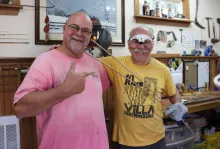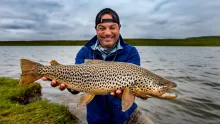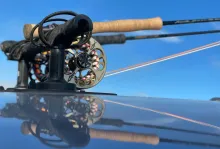Jari Wiklund participated in the Danish Fly Casting Championships and finished second. Read his report from the event and his reflections about casting for the sake of casting and (almost) not a word about fishing. He quotes Lefty Kreh who said:
|
|
|
|
For those of us who like to cast just for the sake of watching those beautiful and narrow loops unravel as a 80+ feet full-line cast comes to completion, a championship with some of the best Danish casters, should be a welcomed opportunity to feast one's eyes on many a harmonious casts. And truly so, with the sun relentlessly baking on the competitors, the first Danish flycasting championship took place in a bit of an awkward wind, which would prove really tricky on the precision course.
When I write the first Danish flycasting championship, this is not completely true, there has been casting championships in the past. But one of the cardinal points of this championship was that this wasn't going to be a casting championship, as in heavy specialized gear, but rather a championship where "real" fishing gear was used, to emphasize that this competition was for flyfishermen and not so much for specialized casters as the previous casting competitions had been.
This championship wanted to present the best in good flycasting, so as to pick up the theme from the other "measure tape" article; what is a good cast? As far as I could observe, all of the winning casts, although maybe not the 8-weight shooting-head distance ones, were beautiful and harmonious casts.
So the conclusion must be that a good cast is a beautiful one, quite in thread with Günter Feuerstein’s comment.
And not only can you become a champion if your casts are beautiful, in my experience, your fishing, or rather the casting part of it, gets more fulfilling and fun when you strive towards beauty and harmony rather than distance. I think this has been the most rewarding gift of all those hours training on grass and perhaps basically what separates the flyfisherman from the spinfisher.
|
|
|
|
But being a bit of a romantic striving towards beauty doesn't win you the championship alone. This being my first Danish casting championship, the unfamiliar feeling of shaking hands due to racing nerves, really had a bad impact on my performance in my favourite discipline: the 5-weight full line distance. But luckily I got one lucky punch and got over the 100 feet mark, which usually is my average under good circumstances, the rest of my casts were way under my average at around 26-27 meters. (86-87 feet).
And as mentioned before the wind was tricky and the slightest tracking-faults were brutally punished by the from-left-and-behind wind, which was blowing at about 3-4 meters/second (7-9 mph.), which is a bit over the point where you normally would move up to a 6-weight or even more, depending on the fishing. The winning cast in this discipline was a 33.4 meters (just shy of 110 feet) cast performed by Morten Olesen.
#5-weight distance gear rules:
Line: Scientific Anglers XXD/Expert Distance competition, a line with an extremely long rear-taper, the whole line being 120 feet! The leader must be between 250 and 300 centimeters (98-118 inches).
Rod: Must be a standard rod (can be bought by anyone/anywhere) and from the manufacturer rated #5, no more than 9'6"
(Very similar to the "Best in the West" rules used stateside)
|
|
Many had estimated the 8-weight competition to potentially deliver one of those illusive 40 meters (131 feet) cast, but the closest was a cast just shy of 35 meters (115 feet). In other words the difference between the 5-weigth and the 8-weight competition was very small, and as an aesthetician, I found that very fulfilling. I have a bit of an ambivalent attitude towards shooting heads, they are very effective and easy-to-use fishing tools, but about the ugliest casting tools ever, at least when you try to push them to the max, they will usually land in a big pile somewhere out there around 35 meters.
I do use them and did throw one out beyond the 33 meters (110 feet) mark, which was enough to give me 2nd place in the 8-weight distance discipline. The wind possibly being a negating factor, although the common perception is that back-wind is a bigger advantage when casting heads, than when casting full-lines.
#8-weight distance gear rules:
Line: Rio products Danish sea trout 18grams (0.63 ounces) shooting head with amnesia monofilament shooting line, leader being between 250 and 300 centimeters (98-118 inches).
Rod: Must be a standard rod (can be bought by anyone/anywhere) and from the manufacturer rated #8, no more than 9'6"
The wind should prove all the more troublesome during the precision discipline. I had big doubts in my own abilities ahead of the precision casts, but was lucky enough to get a few good casts in there. But the common factor was the tricky wind, which would prove very difficult to handle, even for very experienced casters, although you could see the experience in the results. The precision course was made up of 4 "tracks".
The first track being pure precision, hence you had to hit three bulls-eyes at three different distances, the bulls-eyes being a meter (3.28 feet) in diameter (4 points) and having a center with half that diameter (6 points). These bulls-eyes had to be hit from 6, 12 and 18 meters, myself only able to hit the 4-point mark on the 6-meter cast.
The second track, called the "limbo". The caster had to hit the same kind of bulls-eye as described above, but this time it was placed behind a "limbo-stick" that was 1 meter or approximately 3 feet above ground. In other words the caster had to cast under the limbo stick and hit the bulls-eye simulating that big trout under the bridge.
The third track was a straight/slack line track, where the line first had to hit the bulls-eye with the line straight and not tuching two lines that made up a corridor of only half a meter in width. The bull’s eye was about 10 meters away from the caster and this discipline proved very difficult because of the wind. The second part of this track was the slack line cast where you had to touch both the lines with your flyline to get an approved cast.
The last precision track was a curve-cast track, where the bulls-eye was placed behind an obstacle about 10 meters or 30 feet from you. Luckily I pretty much nailed this part of the track and ended up on a third place in the precision contest.
|
|
|
|
Precision gear rules:
Line: Free of choice, but leader must be between 200 and 300 centimeters (79-118 inches).
Rod: Must be a standard rod (can be bought by anyone/anywhere) no more than 9'6"
I made a couple of interesting observations: One would think that people taking casting seriously would bring their own equipment set up just like they wanted it (within the rules of course), but a few casts aside—my own #8-weight as an example—they were all executed using the same setup.
For the #5-weight distance being the Sage TCR, although the winner used an LTS (Loop) and the #8-weight also being Sage TCR, including the winning cast. It could be a coincidence, but mostly I just think this was due to these rods being the ones the arrangers provided as "lending rods".
My point is, that good casters will be able to adjust their casting style to the rod and this ultimately means that there are no bad rods, only bad casters! Of course some rods make casting more fun than others. Most of the precision casts were also made with the Sage TCR #5 setup and this again shows that caster is the dominant factor in flycasting, not the gear, and also that the line used actually is a good precision/presentation line contrary to what some people have written on some unnamed forums in the past.
Another thing that caught my eye, was the fact that on the sideline watching the competition, were some pretty good casters. Why they didn't participate I can only speculate about, but it seems rather silly, considering the huge difference in casting-performance from top to bottom in the participant-field.
All in all I ended up on a 2nd place, which was way better than what I had hoped for, so a very positive experience indeed. As a comment on Martin’s first measure tape article, I would like to quote Lefty Kreh who said: "There is no disadvantage in being able to cast far". I believe this to be very true. It is true that most fishing situations do not call for 25+ meters (80+ feet) casts, but it is very nice to know that you can cast that far, when the situation occurs. And again: being able to cast that far means that you do have good control of the rod in your hand, which besides being fun to learn and continuously develop also is a necessity in effective flyfishing.
- Log in to post comments



















Hi Vanuz, and others
Hi Vanuz, and others interested in the championship.
If you haven't already checked out CFCC's homepage and know about it already, then this might be of interest:
This years championship is going to be held in a month, more precisely on the 20th of may. Directions can be found on their homepage.
I intend to participate, and of course hope to better my score, although I feel that the competition might be harder this year.
Whose fly line was u
Whose fly line was used in the "Best of the West" Casting Contest 2006? What manufacturer?
I really enjoy your website.
Thank you.
Vanuz, the competiti
Vanuz, the competition dates where made public 2 months before on the biggest danish forums, a month before in most of the danish fishing magazines :o) As well as several other websites, mostly those which concerns themselves with the actual act of casting a flyline ;o)
I know the CFCC board wanted to get out a lot sooner, but due to stalling from the city concerning an adequate location to hold the championships (apparently all bigger fields are just meant to be used to kick a piece of inflated leather around) they could not...
Phillip, it would indeed have been the most impartial thing to do, to have the championships indoor, no wind meaning everybody would have the same conditions at all times. The plan was to set up the lanes so the wind would have come directly from behind, and had the forecast been right for that second day of summer, it would have been so. It took about 5 hours to set up all the lanes on saturday, so it wasn't really possible to change them on competition day, though that would have been the most fair thing to do, seeing as there actually was a lefthanded competitior willing to participate ;o) If you have any ideas as to where it could be held indoors I'm sure the CFCC board would like to hear about it, somewhere which has a hall the size of an outdoor football field is needed, and with high enough to the ceilling to cast a flyrod :o)
Jari, nice article, thanks for the kind words! Nice pic, showing my most obvious mistakes in the casts, have to talk to Peter ;o))))
Cheers
Lasse
I was also at the Da
I was also at the Danish Championships - true the wind was certainly a major problem for LH casters. When the casting lanes etc were set up on the previous day the wind wasn't much of a problem at all. It blew up overnight, but it could also have changed direction and come in from the east, then the RH casters would have been at a disadvantage :).
All in all I think it was a great event, the weather was perfect (except for the wind ;)) and the organisers did a great job.
Congratulations to the organisers, the winners and last but not leat to all of those who competed. Well done.
To Phillip: From wha
To Phillip: From what I heard from the arrangers, they had tried really hard to get a wind-free arena to place the whole competition in, but due to them being in the mercy of what the municipal government could/would provide, and not what they could rent, the placement of the competition was as such.
To Vanuz: There has been a lot of debating on the subject and I'm sure that the arrangers would have gone out sooner, had it been possible. I guess that they have learned a good deal on how slow things can go. But I do think that the competition was made "fully" public about a month ahead. At least I saw it in one of the major magazines and it was debated quite a lot on the largest danish online forum. But maybe they should have worked more closely with the national sportfishing association (NSA) and I'm quite sure they will next year. They argumented that their independence of the NSA, meant that they should do it without them, but I think they changed their minds afterwards. You can read more on this discussion on CFCC's forum (in danish).
I was at the Danish
I was at the Danish championships as a spectator just to check it out, and try some of the flyrods on display. The whole "vibe" at the competition seem to be very good and CFCC had done a fine job arranging the event. But in my opinion there was one big mistake about the championships.... THE WIND!!
As I am left handed I wouldn't have had a chance if I had entered the competition. All of the casting ranges were set up so the wind would be in the right direction(from the side) for right handed casters. And some of them were even struggling with the wind in the precision event (as you write in your article). The small gusts of wind made it more than a challenge for some of the competitores.
The solution would obviously be to arrange the next danish championships indoor, to give everyone a fair shot. If this is done I will be one of the first to enter.
...it would be nice
...it would be nice to let the public know such competition takes place, before it actually takes place :(((